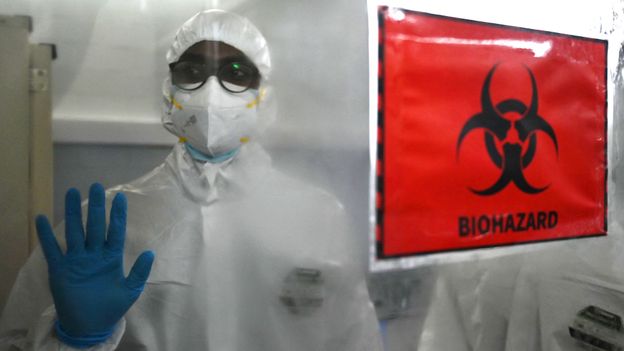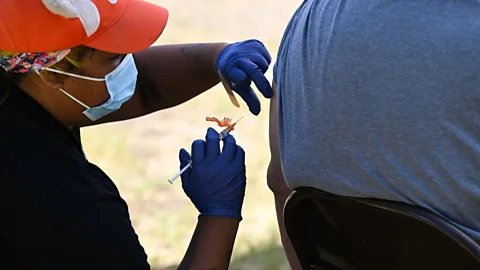 Getty Images
Getty ImagesThe virus that causes mpox, formerly known as monkeypox, was first discovered at the end of the 1950s, but there are signs it has undergone changes in the past three to four years that have enabled it to pass between humans more easily.
The first thing everyone should know about the disease that used to known as monkeypox is that it actually has very little to do with monkeys.
“It was first discovered in monkeys in a laboratory setting in Denmark, it does infect monkeys, and has been isolated from monkeys, but they’re not the primary reservoir for the disease,” says Sagan Friant, an anthropologist at Pennsylvania State University in the United States. “We think of a reservoir as an animal that can transmit the disease but does not suffer or die from it.”
Friant has been studying monkeypox in Nigeria for more than 15 years and was about to begin a new research project just as the Covid-19 pandemic hit. She says it’s likely – but not yet proven – that the monkeypox virus originates in rodents. At the end of 2022, the World Health Organization (WHO) announced it was renaming the virus as mpox.
“For a long time, scientists thought that diseases in primates were the most threatening to humans because of our close similarity genetically, and that’s true,” she says. “But we’re realising that infectious diseases from rodents and bats are of increasing importance when we’re thinking about spill-over of new diseases into human populations.”
Infections that pass from animals to humans are known as zoonotic diseases. Some of these also have the ability to pass from human to human once they make the jump across species.
In that respect, mpox has some similarities to Covid-19. But it’s been around a lot longer than the coronavirus behind the recent pandemic. Recent outbreaks of the disease have alarmed global health officials, however, due to the speed at which is spreading. In August 2024, the Africa Centres for Disease Control and Prevention (Africa CDC) declared a public health emergency over a new variant of mpox that is behind a growing number of cases and deaths in several countries including the Democratic Republic of Congo, Burundi, the Central African Republic and Rwanda. A few days later the WHO declared the surge in mpox constitutes a public health emergency of international concern.
Where did mpox come from?
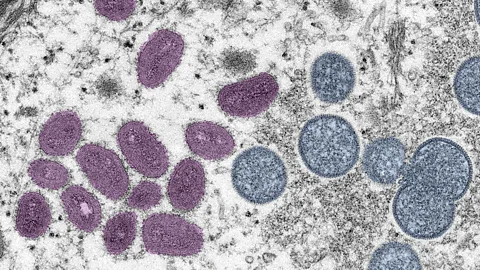 Getty Images
Getty ImagesWhile it is likely there were human cases before this where the virus was not identified – it causes lesions that are similar to those seen in other pox infections such as smallpox – there have since been cases in a number of African countries before the first outbreak in the US in 2003 when 70 cases were reported. It is thought on that occasion the virus was brought to the US in infected prairie dogs. They had been kept as pets and housed with Gambian pouched rats and dormice that were imported from Ghana. Other cases – usually in people who had recently travelled to African countries – have been seen in the UK, Israel and Singapore.
But since May 2022 there have been a spate of outbreaks reported in the US, UK, Australia, mainland Europe, and Canada. While this has worried health authorities and scientists, the number of infections in these outbreaks are a fraction of those seen in Africa, where the disease is endemic. A major outbreak in the Democratic Republic of Congo has seen more than 19,000 cases and 900 deaths since January 2023. The version of the virus causing the DRC outbreak is a more deadly version, known as clade I, compared to the version that caused the 2022 outbreak in the US, known as clade II.
How does mpox spread?
Unlike the virus that causes Covid-19, which primarily spreads through tiny droplets expelled as we breathe and is highly infectious, mpox is not as readily transmissible. It instead relies on close physical contact – usually prolonged – to pass from person to person, or animal to person.
“It could be contact with someone who has an infectious rash, such as lesions, scabs and bodily fluids,” says Madeline Barron, from the American Society for Microbiology (ASM). “You can also get it by touching items that someone who’s infected may have touched.”
A study published in the New England Journal of Medicine found that between April and June 2022, 98% of the infections in 16 countries were in men who have sex with men, but it’s not clear why this is the case. It could just be coincidence – once a disease is introduced to a community, it tends to spread within that community. And there is no evidence that mpox passes any quicker through a population of men who have sex with men than any other group. Nor is there any evidence that it is more infectious to men than women.
“We don’t know if the virus can spread specifically through sexual transmission routes, such as through vaginal secretions or semen, but it seems to be that intimate contact is promoting the spread,” says Barron.
Although DNA from the mpox virus has been detected in semen by researchers, it does not necessarily mean that this is how it is spreading. The mpox virus is a packet of genetic information encased in an envelope of proteins and a membrane. It requires all these components to be in working order if it is to infect cells, and although viral DNA can be detected in semen, the virus itself may not be viable and capable of infection.
How dangerous is mpox?
Another important thing you need to know about mpox is that it is deeply unpleasant. Compared to the Central African strain of the mpox virus, the West African version is generally associated with milder disease and fewer deaths. The mortality rate of the clade I strain is about 10%. For those infected by clade II, 99.9% survive. As of June 2024 there had been 99,176 confirmed cases since the outbreak began in 2022 according to the WHO and 208 reported deaths.
But even if the chances of dying are relatively low, patients with monkeypox have reported how painful and debilitating it is.
“It’s long, it’s nasty and you don’t want to get it,” says Barron. “People may feel flu-like symptoms in the beginning, with fever, headache, stuff like that, but as the disease progresses you get a multi-stage rash, lesions can develop in your mouth, your feet and genital region and these develop into pus-filled blisters.”
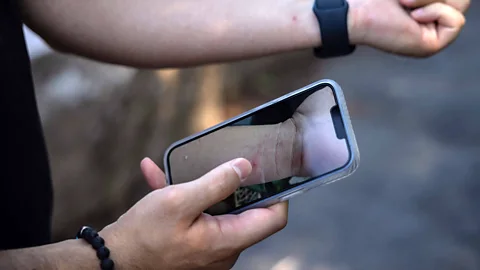 Getty Images
Getty ImagesSome three to four weeks after infection, the blisters will eventually scab over and fall off. Scarring, however, is common in people who recover. There is no specific treatment, other than medicines to treat the symptoms, and, like most diseases, your chances of getting seriously ill or dying depend on factors such as your age and level of immunity.
What perhaps makes monkeypox so shocking is that the symptoms look similar to a disease of the past. One that we thought we had seen the back of thanks to a successful global vaccination campaign: smallpox. Monkeypox is from the same group of viruses as smallpox, although a distinct virus. (Read more about the mysterious virus that helped us eradicate smallpox.)
Is mpox evolving?
Mpox is a brick-shaped virus carrying a double-strand of DNA. This is good news because it means the virus is relatively stable and less likely to mutate into more lethal or more transmissible variants. The Sars-CoV-2 virus that causes Covid-19 contains genetic material made from a single stranded RNA.
“RNA viruses mutate very effectively – they’re diabolical, in my opinion, they’re just really nasty viruses,” says Rodney Rohde, a professor at Texas State University with a background in public health and virology. He is the co-author, with Barron, of a 2022 publication for the American Society of Microbiology on the current state of knowledge about mpox. “DNA viruses typically don’t mutate that quickly, even with the 50 mutations we’ve seen (in mpox), so we don’t see mutations having an impact on the severity of the disease.”
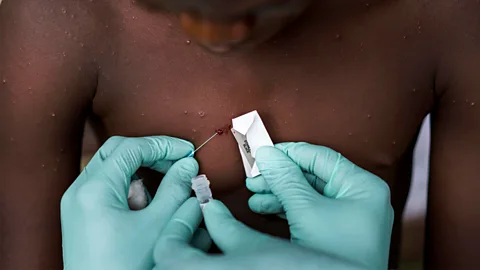 Melina Mara/The Washington Post/Getty Images
Melina Mara/The Washington Post/Getty ImagesPreliminary unpublished research has also identified potential mutations that have yet to be seen in the virus but could alter how pathogenic the disease becomes if they were to occur in the future. But this work, if shown to be correct, could also help health officials and scientists look out for signs mpox is evolving into something more worrisome.
Why mpox became a global health emergency?
Among the reasons for the concern lie in mpox’s relationship to smallpox.
“We probably had a pretty strong herd immunity across the globe when we eradicated smallpox,” says Rohde. “There’s some research that shows that if you go back and look at the population in Nigeria, for example, they probably would have spread monkeypox more efficiently had they not been vaccinated against smallpox.
“Once we stopped smallpox vaccinations, we had waning antibodies – my parents, for example, may have some immunity, but it’s probably really poor.”
How effective are the vaccines?
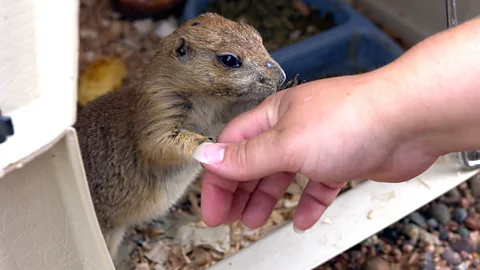 Mike Roemer/Getty Images
Mike Roemer/Getty Images“Many of us have been screaming about these types of issues for decades,” says Rohde. “In my opinion we don’t always think about these things when they’re not on our shores.”
“Those regions where it is endemic, and it’s been a prolonged issue, are still at the short end of the stick in terms of getting the resources, the diagnostics, the vaccines, everything needed to handle the outbreak,” adds Barron. “If Covid has taught us anything it’s that the world is small and you need a coordinated effort to respond to diseases because diseases don’t know boundaries.”
A 2020 United Nations report warned of the growing risk of new diseases passing from animals to humans, exacerbated by our encroachment on natural habitats and the effects of climate change. The bottom line for Friant, who specialises in the health consequences of the interaction between humans and animals, is that we need better monitoring of all potential zoonotic diseases.
“We need more investment in understanding the diseases and preventing that initial spill-over event from animals to humans from happening,” she says. “We also need collaboration and capacity building in countries so that they’re equipped to respond to these events – it definitely shouldn’t just be about protecting the Western world.”
Like Covid-19, mpox is just the latest disease to spread from animals into the human population. Given its relatively slow spread and the fact that vaccines are available to prevent infection, it’s likely mpox outbreaks can be contained. But monkeypox won’t be the last disease of this nature. And the world will need to be ready and vigilant for the next.
* This article was originally published on 2 August 2022. It was updated on 20 May 2024 and again on 13 August 2024 to include details of outbreaks in DRC and some of the latest research on the virus evolution.


